In this article, we discuss the concept of creating a “Betta sorority” tank, where multiple female betta fish are housed together. We explore the reasons for and against keeping a sorority tank, as well as provide tips for successfully setting it up and maintaining it.
For a fish, the betta sorority is a unique name. Perhaps the first question you will be asking, especially if you are into the aquarium hobby, is what is betta sorority? To answer this question in simple terms, they are a group of betta fishes housed together in one tank. It also refers to a tank that holds a group of female betta fish.
However, what must be recognized is that sororities housed together in the same tank may be a success or a total failure. It depends on the actions of the aquarist from the onset of things; one of them is picking the fish to keep in the same tank. Betta sorority’s success depends on the aquarium’s right setup and maintaining the proper tank climate.
Table of Contents
Betta Sorority Tank Overview
A Betta sorority tank refers to an aquarium setup that accommodates multiple female Betta fish. It is important to carefully select compatible females and provide appropriate tank conditions to prevent aggression and stress among the fish.
Information Chart
| Information Chart | Betta Sorority Tank |
|---|---|
| Scientific Name | Betta splendens |
| Temperament | Little aggressive |
| Water Temperature | 75 – 80 degrees F |
| Minimum Tank Size: | 5 gallons |
| Diet: | Carnivore (frozen/dry foods, granules/flakes) |
| Lifespan: | 3 years |
| Size: | 2.5 inches to 3 inches |
| Care Level | Medium to difficult |
| Water Condition | pH 6 to 8 |
Bettas Fish Life Span and Facts
Bettas are well-known to identify their human companies, and they will follow the keeper’s finger around the tank. Besides, you can also train your bettas to do some tricks. As per the experts, the average lifespan of Bettas is around 3 to 5 years. However, if you follow this care guide properly and provide them with all the required care, your bettas can live around 8 to 9 years in your aquarium.
Origin Of Betta Fish
Also called siamese fighting fish, bettas’ native home is Laos’s Mekong basin, Thailand. Besides, they also can be found in Indonesia, Malaysia, Cambodia, and different parts of China.

Speaking about the natural habitat of the bettas, they love to live in moving streams, rice paddies, and shallow ponds with a water temperature of around 75 to 80-degree C. Bettas belong to a group called labyrinth fish and can easily survive in little water.
Types Of Bettas
Here are some of the most popular types of bettas that you can buy. The majority of them acquired names based on the shape of their tails.
Delta Bettas
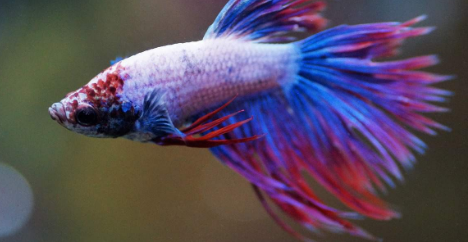
Delta Bettas come with straight tails with caudal edges. They have a shiny color combination of blue and red and remain active most of the time.
Elephant Ear Bettas

Elephant ear bettas come with ruffled and large pectoral fins that look like the ears of an elephant. Most of them have half-moons tails. Their fins are around 3 times bigger than normal bettas’ fins.
Rose-Tail Bettas

Professionals generally breed rose tail bettas from halfmoon species. If you look at the caudal fins, you will find them with extra rays, branching, and ruffled edges. The tail can fold back and forth itself.
Combtail Bettas

Combtail bettas also have rays at the fins, but you will find the webbing is larger than other species and that can reach around ⅔ of its tail.
Feather Tail Bettas

Feather tail bettas will look like rose tail bettas, but their fin rays have more branching compared to others. On the other hand, they have a more ruffled look.
Plakat Bettas

Plakat bettas are considered the ancestors of the betta species. They come with shorter tails with space or round shapes. They are strong and less prone to disease and injuries.
What Determines Whether a Betta Sorority Will Be Successful?
The success of a Betta sorority, a group of female Betta fish living together, depends on factors such as proper tank size, compatible personalities, and gradual introduction to minimize aggression and territorial behavior.
Personality Of Each Fish
Many new aquarists, especially those who are still not conversant with sororities, are usually not well-versed in how much aggression there should be in the tank. While aggression is an instinct for competing for food and marking territory in female betta fish, ignoring things is not a good idea.
When you first introduce your female betta sorority into the tank, it will be natural for them to fight off each other. Their body slapping may characterize this, chasing, flaring, orbiting.
The Size of The Tank
The minimum tank capacity for holding your betta sorority together should be 10 gallons and nothing less. The tank can be bigger than the minimum requirement of 10 gallons. Since the female bettas are territorial, they require the space to create their domains comfortably.
When the space is too small for them, more fights will erupt amongst them, something that will cause stress or even death. A great tank for the fish should be wider instead of taller, as this helps to give the fish more space to spread and even get away from bullies.
Shelter And Hiding Places
You need to create sufficient hiding places using different items in the tank as betta loves hiding and resting under a hiding place. Don’t use any sharp objects to make such places.
How You Introduce Them To Each Other
Creating a betta sorority involves introducing female betta fish to each other to live peacefully in the same tank. This process requires careful steps to ensure proper acclimation and socialization, allowing the bettas to coexist harmoniously and form a community in the aquarium.
Now that you have everything ready such as the tank and the water, the ultimate test will be choosing the bettas in the tank. It is important to choose healthy bettas in your tank.
Because choosing a single unhealthy betta can end up contaminating the entire fish tank, thereby becoming more vulnerable to diseases in the tank
The Right Number Is Important
It is safe to introduce at least four bettas in the same tank but not less than four. It is best to have even more of them in the tank. If you have fewer than four bettas in the same tank, the bettas can bully the weakest betta, which could lead to death.
But even as you proceed to add numerous bettas in the tank, ensure that they don’t exceed 6 in a 10 gallons tank. Having too many in a small tank can also be dangerous.
Be Sure That It Is A Female Betta
Some experienced aquarists are unaware of this, but female bettas usually have an ovipositor on their belly, showing a white speck. The female betta fish has a simple coloration and features.
At the same time, male betta fishes dominate and have longer fins. That still doesn’t rule out that you might select a male mistaken for a female. Basically, during selection, you have a big chance to choose a male betta fish with shorter fins than a female!
Get Female Betta That Is Familiar With One Another
While choosing betta fishes to put in the tank, select those that have grown closer to each other cups. Since they have shown less aggression toward each other, they accept their familiarity with each other. It’s a plus point when you’re selecting the female betta fishes!
Choose Younger Female Bettas
When choosing your female bettas to take with you, it is best to choose those still young because young ones are not very aggressive.
Add Bettas That Look Different
When choosing the bettas to put in a single tank, it is slightly better to go with different betta fishes. If all the bettas are of different types, it will reduce the chances of aggressive fighting between the fishes.
Betta fishes don’t mingle or attack fishes that are not similar to them, which is a plus point. For more details about different types of bettas, you can go through the type of bettas section in this article.
Add All Bettas at The Same Time
When it is finally time for you to add them to the tank, try to introduce all the fishes simultaneously. It will lower the chances of them creating territories and fighting each other for space.
As a rule, however, when the fighting starts within a few days, it will just go away. However, there are times when you will need to intervene to save things, especially when you see sustained fighting where there is an injury.
It may be best to remove the aggressor and place her in a separate tank. Another situation in which you will need to intervene is to rescue a bullied, weaker female and place her in a different tank from the bullies.
Setting Up A Betta Fish Sorority Tank
Setting up a Betta fish sorority tank involves certain steps and considerations, including selecting compatible female Betta fish, providing adequate tank size and habitat, and carefully monitoring the fish for signs of aggression or stress.
Your female betta may live in a sorority environment that is very peaceful but may have to work hard to compete for food with the other tankmates. She will also have to mark her territory, and most of all, she will still have to contend with living near other aggressive and territorial fish.
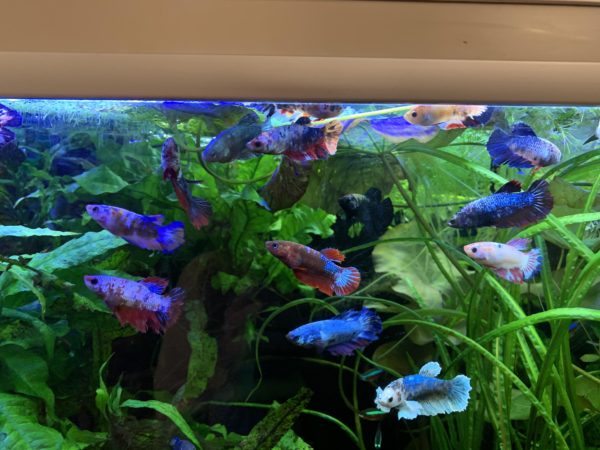
Because stress is usually the leading cause of outbreaks in these fishes kept in enclosures, you should ensure to reduce stress. The keepers must pay special attention to the water quality in the tank. There is a chance of the bettas having weak immunity.
Filter And Heater
Speaking about the best filter, you need to buy a filter that can effectively filter the fish tank multiple times every hour and ensure that the filter doesn’t produce much flow. As per the experts, internal filters or sponge filters are some of the good filter options for your betta fish.
Choose an ideal filter for around 70- gallons of water and can offer multiple forms of filtration. These species prefer to live in shallow and slow-flowing water in their natural habitat. Besides, you need to use well-heated water to maintain a suitable water temperature.
They prefer to live in water temperatures of 72-degree to 82-degree F. Under a temperature below 72-degree F, your Bettas will become inactive, leading to infection.
Creating Hiding Places
It is best to offer your fish as much cover as possible; you can use driftwood, rocks, foliage, freshwater plants, etc. Such cover helps provide the much-needed cover from bullies and, in effect, helps minimize conflict amongst the fishes inside the tank.
Use A Tank Cover
While chasing each other, Betta fish can jump out of the aquarium. So, it is advisable to keep your tank covered all the time. Besides, you can prevent other items from falling into the fish tank by covering the tank. Some can even kill your Betta fish.
On the other hand, you will deal with frequent water evaporation without a cover, and you will have to refill the tank very frequently.
Use Water Conditioner
To keep your betta fish stress free and healthy, you should use a good quality water conditioner. Experts suggest using an anti-chlorine water conditioner that works quite effectively in creating a suitable water condition.
Besides, these conditioners can also remove other harmful elements from the water, such as cyanide, arsenic, and mercury. However, while using these products, ensure that you follow the dilution instructions mentioned on the products.
Tank Landscape
As discussed above, bettas are territorial fish species,and to keep them healthy and active for years, you need to create a lot of hiding spaces in your fish tank. To create hiding places, you can use plants, especially live plants, hallow decorations, rocks, and more.Keep reading to know more about betta sorority tank landscape.
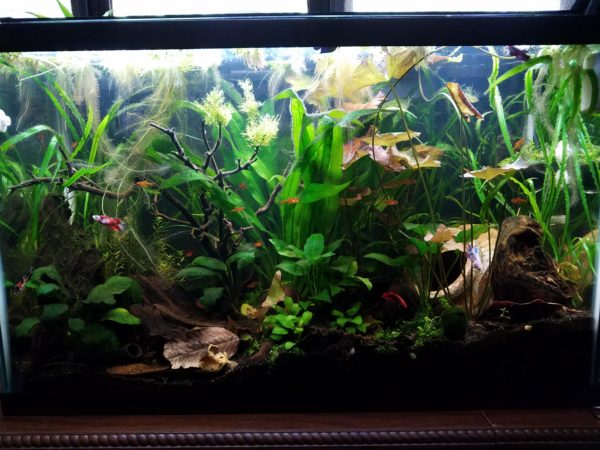
Plants For Your Betta Sorority Tank
If you are looking for an effective way to take your betta sorority tank to a whole new level, you can give live aquarium plants a try. Using live plants, you can effectively purify the water and can also offer a natural and beautiful environment to your Bettas. As per the experts, aquarium plants serve as a perfect enrichment for your bettas to block sight when they get territorial. Besides, plants offer resting places.
However, you should avoid plants that can lead to fin trauma. Sharp objects within their living environment can lead to fin rot. And this can happen due to both live and fake plants, based on the plants’ structure as well as exposed roots. If you are looking for some good plants to add into your Betta Sorority tank, then here are some options for you:
- Java Fern
- Anubias
- Marimo Moss Ball
- Water Sprite
- Bett Bulb
- Vallisneria
Well, if you don’t want to use live plants for your tank, then you can use silk ones. Professional aquarists don’t suggest using plastic plants as their sharp edges can lead to serious consequences.
Best Substrate Types for Your Betta Sorority Tank
The best substrate types for a betta sorority tank depend on the specific needs of the fish and the desired aesthetic. Some recommended options include fine sand, smooth gravel, or planted substrates. The substrate should be suitable for easy cleaning and provide a comfortable environment for the bettas.
As discussed above, Bettas are native to Southeast Asia’s Mekong River. Speaking about their native range, it may include Vietnam, Thailand, Laos, and more. They love to live in rice paddies, floodplains, and slow-moving waterways. And such habitats have muddy and silty bottoms created with leaf litter. Well, creating such a type of environment in your fish tank can be very difficult.
Sand
However, you can use aquarium gravel or sand as your fish tank substrate. Gravels are the best option for some aquarists as they don’t clump together. As a result, the chance of the creation of Hydrogen Sulphide will be very low. On the other hand, when you use gravel, it will be easier for you to vacuum uneaten food. Besides, they allow beneficial bacteria to grow.
Gravel
Some betta owners prefer to use sand as a substrate. Sand is a clean type of substrate and is visually appealing. While using sand, you don’t have to worry about sharp edges. But you should keep in mind that you can’t use an under-gravel filter if you are using sand. Besides, you will have to stir them regularly to prevent the formation of Hydrogen Sulphide in the tank.
You can also use stone aggregate and marbles for your fish tank bottom.
Tank Decoration
Betta Sorority tank decoration can offer different benefits. For example, using the right type of tank decoration, you can keep the fish happy. Besides using different decorative items, you can create hiding space for them, for example, small caves, driftwood, and more. Furthermore, you can use betta toys to keep them active. Some of the best tank decoration items that you can add to the tank include a small mirror, marimo moss ball, ping pong ball, floating log, sinking ceramic log, live plants, and more.
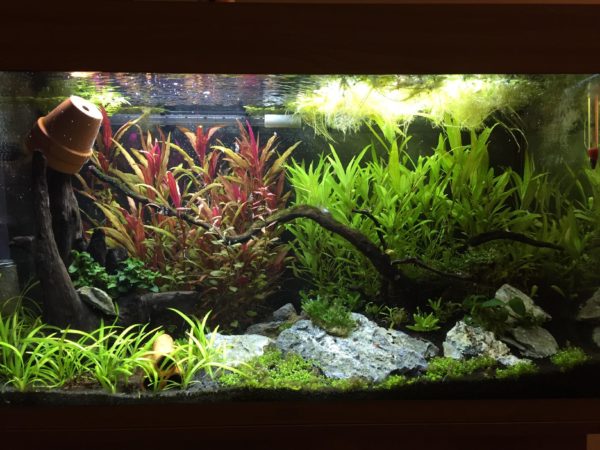
You should not use décors that are made of metal as this will rust and affect water parameters. Some tank decorations may have sharp edges. So, be careful about that. Don’t place the decorations in such a way that the bettas could wedge, entangle or confine themselves.
It has been seen that some people prefer to put terracotta plant pots in the tank. You should not do that as it can lead to various fish injuries. A terracotta plant pot’s drainage hole has sharp edges, and when your bettas swim through it, the hole can lead to deep and huge graze.
Don’t use plants made of plastic with sharp edges. Remember that betta fish fins are quite delicate.
In terms of lighting, you can use aquarium LED lights to create a better environment during days and at night. Make sure that the lights don’t produce much heat.
The Nitrogen Cycle
Speaking about the nitrogen cycle, it is a biological reactions chain that can create harmful chemical results. Fish waste and decaying food produce ammonia. It is toxic and can kill your Betta fish. But ammonia is also a good source of food for nitrifying bacteria.
The bacteria consume ammonia and toxic nitrite. To keep the nitrate amount at a safe level, you should properly filter your aquarium’s water. Remember that the nitrogen cycle keeps your water chemically balanced.
It is crucial to regularly test your aquarium’s water and then make necessary changes by performing a water change, treating the water with water conditioners, ammonia neutralizers, and replacing the activated carbon.
Feeding Your Betta Sorority
In general, betta fish are carnivores. The diet should include a sufficient amount of protein. Experts suggest treating your bettas with betta-specific flakes, pellets, and frozen brine shrimp. Sometimes offering them live brine shrimp can also be a good idea.
Sometimes, your new betta sorority may not eat properly. But don’t worry about this. They can take time to get adjusted to the new habitat.
It is crucial not to overfeed them. Feeding betta too much can lead to bloating. Besides, the water can get dirty faster due to the accumulation of uneaten food. It would benefit if you fed the fish one to two times every day, which will be enough for them.
How To Care for Your Betta Sorority
Caring for a Betta Sorority involves setting up a suitable environment for a group of female betta fish. This includes selecting a tank of at least 10 gallons, providing enough hiding places, and ensuring optimal water conditions. It’s crucial to introduce bettas carefully to avoid aggression, maintain water quality, and manage feeding and tank cleanliness.
Change The Water Regularly
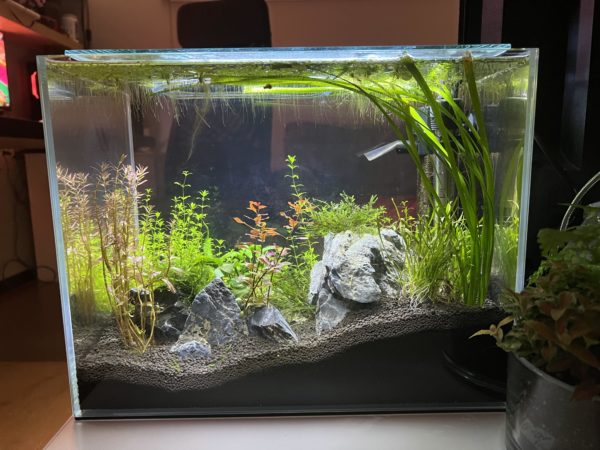
If you have a small tank, it is advisable to change around 10 to 15 percent of the water every week. Changing around 20 percent of the water can work great for a larger aquarium. Always apply a dechlorinator before adding fresh tap water into your aquarium.
Vacuum The Gravel
The aquarium’s maintenance requirements can vary based on the setup, equipment, and time. You can install a good filtration system to keep the water quality optimal. But to keep your bettas healthy, you should clean the gravel, and the best way to do that is by vacuuming. This way, you can easily remove waste, dead plant material, and excess food.
Keep An Eye on Filter
You should keep the tank filter clean to maintain the oxygen level in the tank. The filter can get dirty after a few days. So, keep checking them frequently and clean them whenever required.
Remove Uneaten Food
It is crucial not to overfeed them. It can lead to bloating. Besides, if there are any uneaten foods, the water will get dirty faster. It would be best to feed them one to two times every day, which will be enough for them. If there is any uneaten food, remove that as soon as possible.
Risks Associated with A Betta Sorority Tank
Setting up a betta sorority tank for the first time may not work well, especially for newbie aquarists. Keeping any two territorial animals in a similar tank requires a lot of effort. The betta females are less aggressive, but the territorial males will fight for their space in the tank.
If you don’t monitor the sorority carefully, things can go downhill pretty soon. For example, your bettas can bully others and bite their fins.
On the other hand, not all of them will get proper food leading to different health issues. So, make sure you spend more time feeding them properly to create a successful Betta Sorority tank.
Is A Betta Sorority Right for You?
Well, betta sorority is a controversial concept in the fish world. Some owners don’t support this, but some have successfully maintained a betta sorority for the longest time.
All you need to do is create a perfect environment for them, for example, adding a heater, water filter, hiding spaces, and more. And make sure that your betta sorority has four to five females.
FAQs
Can A Male Betta Live with A Sorority?
In general, one can keep one male Betta fish with a sorority of female betta fish. But several experts suggest keeping an eye on the community and ensuring that the male betta is not behaving aggressively with the females. Besides, always keep a quarantine tank ready to remove the male from the tank if things go wrong.
When To Split Up a Betta Sorority?
Don’t lose hope if you have a betta sorority and your bettas are not getting along. Sometimes, it can take time. But if you still face the same issues and the females are still showing aggressive behavior after seven to ten days, you should split them up.
Conclusion
Creating the perfect betta sorority requires a lot of consideration due to the nature of betta fishes. However, it is possible with proper planning and preparation, and you never know that you might end up with one of the best tanks you have ever set up. So go ahead and start planning for your next betta sorority tank.
No related posts.
